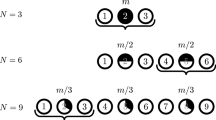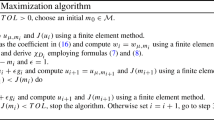Abstract
This paper is concerned with a nonlinear optimization problem that naturally arises in population biology. We consider the effect of spatial heterogeneity on the total population of a biological species at a steady state, using a reaction–diffusion logistic model. Our objective is to maximize the total population when resources are distributed in the habitat to control the intrinsic growth rate, but the total amount of resources is limited. It is shown that under some conditions, any local maximizer must be of “bang–bang” type, which gives a partial answer to the conjecture addressed by Ding et al. (Nonlinear Anal Real World Appl 11(2):688–704, 2010). To this purpose, we compute the first and second variations of the total population. When the growth rate is not of bang–bang type, it is shown in some cases that the first variation becomes nonzero and hence the resource distribution is not a local maximizer. When the first variation becomes zero, we prove that the second variation is positive. These results implies that the bang–bang property is essential for the maximization of total population.
Similar content being viewed by others
References
Berestycki, H., Hamel, F., Roques, L.: Analysis of the periodically fragmented environment model. I. Species persistence. J. Math. Biol. 51(1), 75–113 (2005)
Cantrell, R.S., Cosner, C.: Diffusive logistic equations with indefinite weights: population models in a disrupted environments. Proc. R. Soc. Edinb. 112A, 293–318 (1989)
Cantrell, R.S., Cosner, C.: Spatial Ecology via Reaction–Diffusion Equations. Series in Mathematical and Computational Biology. Wiley, Chichester (2003)
Ding, W., Finotti, H., Lenhart, S., Lou, Y., Ye, Q.: Optimal control of growth coefficient on a steady-state population model. Nonlinear Anal. Real World Appl. 11(2), 688–704 (2010)
Kao, C.Y., Lou, Y., Yanagida, E.: Principal eigenvalue for an elliptic problem with indefinite weight on cylindrical domains. Math. Biosci. Eng. 5(2), 315–335 (2008)
Lamboley, J., Laurain, A., Nadin, G., Privat, Y.: Properties of optimizers of the principal eigenvalue with indefinite weight and Robin conditions. Calc. Var. Partial Differ. Equs. 55, 144 (2016)
Lou, Y., Yanagida, E.: Minimization of the principal eigenvalue for an elliptic boundary value problem with indefinite weight and applications to population dynamics. Jpn. J. Ind. Appl. Math. 23(3), 275–292 (2006)
Nadin, G.: The principal eigenvalue of a space–time periodic parabolic operator. Ann. Mat. Pura Appl. (4) 188(2), 269–295 (2009)
Nadin, G.: The effect of the schwarz rearrangement on the periodic principal eigenvalue of a nonsymmetric operator. SIAM J. Math. Anal. 41(6), 2388–2406 (2010)
Roques, L., Hamel, F.: Mathematical analysis of the optimal habitat configurations for species persistence. Math. Biosci. 210(1), 34–59 (2007)
Skellam, J.G.: Random dispersal in theoretical populations. Biometrika 38, 196–218 (1951)
Author information
Authors and Affiliations
Corresponding author
Additional information
Communicated by Y. Giga.
The authors would like to express their sincere thanks fo Professor Yuan Lou for his valuable suggestions. They also thank Professors Yoshihiro Tonegawa and Masashi Aiki for helpful advice. The second author was supported by JSPS KAKENHI Grant-in-Aid for Scientific Research (A) (No. 17H01095).
Rights and permissions
About this article
Cite this article
Nagahara, K., Yanagida, E. Maximization of the total population in a reaction–diffusion model with logistic growth. Calc. Var. 57, 80 (2018). https://doi.org/10.1007/s00526-018-1353-7
Received:
Accepted:
Published:
DOI: https://doi.org/10.1007/s00526-018-1353-7




